
95% of researchers rate our articles as excellent or good
Learn more about the work of our research integrity team to safeguard the quality of each article we publish.
Find out more
ORIGINAL RESEARCH article
Front. Earth Sci. , 10 February 2022
Sec. Economic Geology
Volume 9 - 2021 | https://doi.org/10.3389/feart.2021.786849
This article is part of the Research Topic Progress in Exploration, Development and Utilization of Geothermal Energy View all 28 articles
The study of tectono-thermal evolution of sedimentary basins reveals both geothermal field characteristics and hydrocarbon generation and expulsion in the basin. However, there are only a few studies on the tectono-thermal evolution of the Fuyang Sag. This means the hydrocarbon exploration in the study area is restricted and unable to be effectively supported. Based on the geophysical exploration and drilling results, the tectono-thermal evolution of the Fuyang Sag has been studied for the first time in this paper. Using the organic geochemical data of the source rocks, the influence of tectono-thermal evolution on hydrocarbon exploration in the Fuyang Sag was discussed. The burial history of the Fuyang Sag since the late Paleozoic falls into four stages: stable sedimentation, rapid subsidence and deposition, long-term continuous uplift and denudation, and sedimentation. The heat flow evolution history of the Fuyang Sag since the late Paleozoic is characterized by ascending first and descending afterward. The main source rocks in the sag increased rapidly during the Permian and was gradually finalized in the Yanshanian period. The Fuyang Sag was reformed after the early hydrocarbon generation. The main source rocks with deeper burial depth, weaker uplift, and denudation reformation have greater potential for hydrocarbon exploration in the sag. The results of this study provide not only a scientific basis and important guidance for hydrocarbon exploration in the Fuyang Sag, and but also effective geothermal constraints for further geodynamics research in the Southern North China Basin.
As a driving force of various geodynamic processes (Morgan, 1984; Wang, 1996), heat is also an important influencing factor of oil and gas accumulation (Welte and Tissot, 1984; Tissot et al., 1987; Qiu et al., 2004). In the geological history, the thermal state of sedimentary basin changed dynamically with tectonic evolution, including the evolution of formation temperature, geothermal gradient, and heat flow (Qiu et al., 2005). Therefore, it is of significance to study the tectono-thermal evolution of sedimentary basin. On the one hand, the research reveals the characteristics of the geothermal field in different evolution stages of the basin and illustrates effective constraints for the analysis of dynamic mechanism and tectonic attributes of the basin in a specific period of geological evolution (Hanks et al., 2006; Hu et al., 2007; Qiu et al., 2014; Liu et al., 2016; Gao et al., 2018). On the other hand, the research restores the thermal maturity process and hydrocarbon generation and expulsion stages of organic matter in source rocks, to provide a scientific basis for oil and gas exploration in the basin (Zhu et al., 2010; Zuo et al., 2011; Li et al., 2013; Zuo et al., 2013; Tang et al., 2014).
For a long time, many structural units in the Southern North China Basin (SNCB) have been studied, including oil and gas exploration potential (Wu et al., 1992; Wang et al., 1999; Zhao et al., 2001; Xu et al., 2003; Xu et al., 2004; Yu et al., 2005; Xie et al., 2006; Xie and Zhou, 2006; Liu et al., 2009; Zhao et al., 2010; Xu et al., 2011), but the relevant research on the Fuyang Sag, one of its structural units, was relatively scarce. The burial history, organic matter maturity evolution history, and hydrocarbon generation history of source rocks in the Fuyang Sag have not been studied yet, which are vital to oil and gas exploration. The oil and gas exploration in the Fuyang area was therefore restricted and ineffectively supported. Furthermore, the SNCB is located at the tectonic junction of the Dabie Orogenic Belt and the Tancheng-lujiang Fault Zone. Its tectonic evolution history is vital to understanding the basin-orogene coupling process in eastern China. The Fuyang Sag is located in the middle of the SNCB, which is a critical position for basin research. The lack of tectono-thermal evolution of such a position cannot support the geodynamics research of the basin-orogene coupling.
In recent years, based on the drilling and geophysical exploration carried out by the Oil and Gas Survey, China Geological Survey in the Fuyang Sag, the stratigraphic development in the sag was revealed (Gao et al., 2021), and many types of geological data in the sag were obtained. Based on these basic geological data, the tectono-thermal evolution of the Fuyang Sag is studied for the first time. Combined with regional geological background, two-dimensional seismic survey, and drilling data, this study reconstructed the stratigraphic burial history of the Fuyang Sag, restored heat flow and formation temperature evolution history of the Fuyang Sag by using vitrinite reflectance measured from drilling cores and cuttings as paleo-geothermometers. Furthermore, the maturity evolution and hydrocarbon generation history of the main source rocks in the Fuyang Sag was reconstructed. Combined with source rock organic geochemical data, this study discusses the influence of tectono-thermal evolution of the Fuyang Sag on oil and gas exploration in the study area. The results of this study are significant for guiding the hydrocarbon exploration in the Fuyang Sag and can also provide effective constraints for further geodynamics research in the SNCB.
The Fuyang Sag belongs to the SNCB tectonically (Figure 1). It is regionally controlled by the Dabie Orogenic Belt in the south and the Tancheng-lujiang Fault Zone in the east. It is a secondary tectonic unit developed and formed on the basement of the North China Craton, with an area of about 10,000 km2 (Lu et al., 2011). The regional geological background shows that the Fuyang Sag is located at the junction of the North China Block and the Dabie Orogenic Belt, and the basin evolution since the Paleozoic has different features, which can mainly be divided into two stages: Paleozoic stable subsidence and Mesozoic-Cenozoic deformation and transformation (Xu et al., 2003; Sun et al., 2004; Huang et al., 2005; Yu et al., 2005; Kuang et al., 2009; Yang et al., 2012).
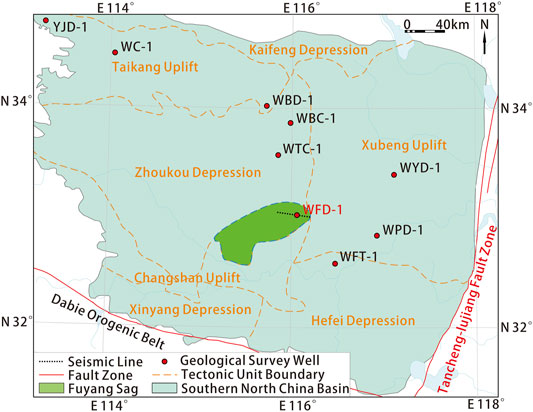
FIGURE 1. Map showing the location of the Fuyang Sag and the main structural subdivisions of the Southern North China Basin.
According to the drilling strata of WFD-1 (Figure 2), the only geological survey well in the Fuyang Sag, the strata developed from the top to bottom are Quaternary, Neogene, Paleogene, Permian Shangshihezi Formation, Permian Xiashihezi Formation, Permian Shanxi Formation, Carboniferous Taiyuan Formation, Carboniferous Benxi Formation, and Ordovician Majiagou Formation, respectively. The Permian Shangshihezi Formation (P2s) is dominated by mudstone and sandstone, with coal seams concentrated in the middle, and its sedimentary environment is dominated by the delta sedimentary system, interspersed with the coastal system. The Permian Xiashihezi Formation (P2x) is characterized by the interbedding of sandstone, mudstone, and coal seams, which belongs to the distributary channel deposition of the delta plain. The Permian Shanxi Formation (P1s) is interbedded with sandstone and dark mudstone and intercalated with several thin coal seams, which is a delta sedimentary environment formed during regression. The Carboniferous Taiyuan Formation (C2t) is composed of epicontinental sea carbonate rocks and coastal clastic rocks, and the main sedimentary environment is lagoon facies and marsh facies. The Carboniferous Benxi Formation (C2b) is a set of purplish-red ferric aluminum mudstone, and its sedimentary environment is the lagoon and epicontinental sea. Ordovician Majiagou Formation (O2m) mainly developed limestone formed in an epicontinental sea sedimentary environment (Gao et al., 2021).
The 2D seismic profile (Figure 3) across the Fuyang Sag depicts the east-west structural pattern, fault characteristics, and stratigraphic distribution of the Fuyang Sag. The Fuyang Sag is a dustpan-shaped fault depression with east-west distribution formed by the influence of the Cenozoic regional extensional tectonic environment. The sag presents a structural form of steep in the west and gentle in the east. A series of normal faults dipping eastward are developed on the west side of the sag, while a series of normal faults dipping westward are developed on the east side of the sag. All faults in the sag developed before the Neogene and ended up below the Neogene. The Carboniferous-Permian strata in the sag are continuously deposited, the Permian Shangshihezi Formation is in unconformable contact with the overlying Paleogene, and the strata inbetween are missing due to structural denudation (Liang and Liu, 2014). There is little difference in thickness between the Carboniferous-Permian and the Neogene in the east and west of the sag. The Paleogene is thinner in the east and thicker in the west of the sag.
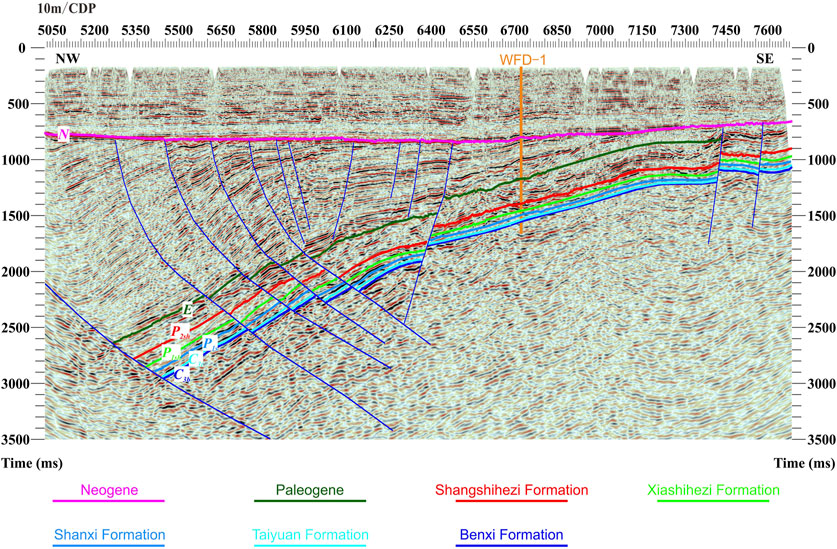
FIGURE 3. 2D seismic profile across the Fuyang Sag. Its location is shown in Figure 1. Different color lines refer to different formation bottom interfaces. The blue curves represent faults. The yellow straight line shows the location and depth of well WFD-1 on this seismic profile.
There were oil and gas displays shown in the structural units in the adjacent area of the Fuyang Sag, and in different strata such as Paleogene, Lower Cretaceous, Permian, Upper Carboniferous, Ordovician, and Cambrian (Wu et al., 1992; Xu et al., 2004; Xie et al., 2006; Xie and Zhou, 2006; Zhang, 2016). The geochemical analysis shows that all the liquid hydrocarbons have the characteristics of high saturation hydrocarbon and low asphaltene and belong to coal-derived oils from the Carboniferous-Permian system. Previous studies on reservoir forming conditions and geochemical characteristics of source rocks suggested that the main source rocks in this area are the Carboniferous-Permian coal-measure source rocks, with source-reservoir-cap assemblage, but the reservoir physical property is poor (Ma, 2006; Zhu et al., 2006).
The research of basin-scale tectono-thermal evolution is to use the paleo-geothermometers that record paleo-temperature information in the basin to inverse the thermal history of sedimentary strata (Price, 1983; Hu et al., 2001). There are many types of paleo-geothermometers, among which the vitrinite reflectance (Ro) is a well-developed paleo-geothermometer recording the highest paleo-temperature. In addition, a variety of dynamic models have been established for using vitrinite reflectance to reconstruct thermal history (Waples, 1980; Lerche et al., 1984; Tissot et al., 1987). In this study, “EASY%Ro” model, a widely used and simplified model (Burnham and Sweeney, 1989; Sweeney and Burnham, 1990), was adopted as the dynamic model of vitrinite reflectance.
The 40 vitrinite reflectance data of the Fuyang Sag were obtained from the test results of cores and cuttings drilled by WFD-1. The tested samples were all from the Carboniferous-Permian strata, with depths ranging from 1500–2000 m and Ro ranging from 0.86 to 1.27%, with an average of 1.05% (including 23 core samples with an average Ro of 1.06%, and 17 cutting samples with an average Ro of 1.04%). The Ro values both from cores and cuttings show no significant change with the increase of depth (Figure 4). This indicates that the Carboniferous and Permian vitrinite reflectance data were generally more consistent and had experienced the same thermal evolution history. Combined with the current geothermal gradient of 25°C/km in the Fuyang Sag, the measured Ro values of the Carboniferous-Permian were higher than that of the formation temperature at the current buried depth, indicating that the formation had experienced higher paleo-temperature. This situation may be caused by early geothermal events or later uplift and denudation.
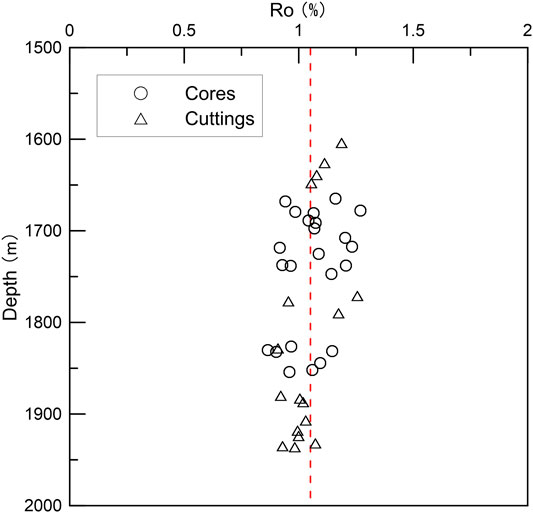
FIGURE 4. Plot of measured vitrinite reflectance (Ro data) vs. depth from WFD-1. The circles represent core samples, and the triangles represent cutting samples. The red dashed line refers to the average Ro value of 1.05%.
The software used in this thermal history modeling was the Thermodel for Windows. Default parameters in the Thermodel for Windows were used for the initial porosity, matrix density, and heat capacity. The paleo-surface temperature was set as 10°C during the geological evolution. Mechanic compaction coupled with the reciprocal porosity-depth relationship (Falvey and Middleton, 2005) was used to model the burial history. The effect of compaction was accounted for using Sclater and Christie’s model (Sclater and Christie, 1980). According to previous studies on denudation in the Fuyang area (He, 2009; Yang, 2017), the amount of denudation between the Permian and Paleogene in the Fuyang Sag was about 2500 m. Based on regional geological and geophysical data, drilling results, and previous research, the burial history of the Fuyang Sag was reconstructed. With vitrinite reflectance as paleo-geothermometer, the thermal history of the Fuyang Sag was studied using the paleo heat flow method. Based on the above study, the maturity evolution history of the Carboniferous-Permian source rock in the Fuyang Sag was modeled by the “EASY%Ro” dynamic model.
The reconstructed burial history and deposition (erosion) rate of the Fuyang Sag are shown in Figures 5, 6 respectively. The burial history of the Fuyang Sag from the Late Paleozoic to the present day can be divided into four stages. Before the Middle Permian, the Fuyang Sag was in a stable sedimentation stage, with a deposition rate of about 3–36 m/Ma. After the late Permian, the Fuyang area experienced the peak of the Indosinian movement. Influenced by the convergence and collage of the North China Block and the Yangtze Block, rapid sedimentation occurred, with a deposition rate of about 82–277 m/Ma. This rapid sedimentation lasted for a short period, only about 18 Ma. Subsequently, the Fuyang Sag entered the Yanshan Movement, with a long-term continuous uplift and denudation until the Cenozoic, and the erosion rate was about 14 m/Ma. In the Cenozoic, the Fuyang Sag turned into a sedimentation stage. The Paleogene deposition rate was about 12 m/Ma, and the Neogene deposition rate was about 34 m/Ma.
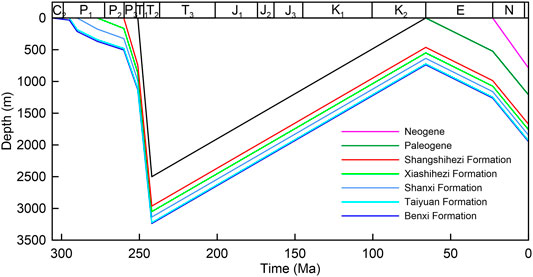
FIGURE 5. Burial history of the Fuyang Sag. Different color lines refer to the modeling results of burial depth evolution path of different formations with geological time.
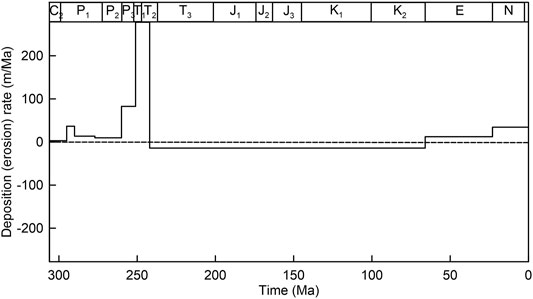
FIGURE 6. Deposition (erosion) rate of the Fuyang Sag. The broken line represents the deposition (erosion) rate of the Fuyang Sag in each geological time. The dashed line refers to the deposition (erosion) rate of 0 m/Ma. It means deposition when the rate is greater than 0 m/Ma, and it means erosion when the rate is less than 0 m/Ma.
Based on the present-day geothermal field and paleo-geothermometer data in the study area, the heat flow evolution history of WFD-1 since the late Paleozoic was systematically reconstructed (Figure 7). The evolution history of heat flow in the Fuyang Sag since the late Paleozoic was characterized by rising first and falling afterward. The terrestrial heat flow in the Fuyang Sag was about 53 mW/m2 in the late Paleozoic. At the end of the Indosinian period, due to the tectonic background of the collision and compression of the North China Block and the Yangtze Block, the terrestrial heat flow rose slightly to about 56 mW/m2. Since then, the Fuyang Sag continued to be in the uplifting and cooling stage, and the terrestrial heat flow slowly dropped to about 50 mW/m2. In the Cenozoic era, the terrestrial heat flow in the Fuyang Sag tended to be stable and maintained at about 50 mW/m2. The temperature evolution of strata in the Fuyang Sag is influenced by tectonic subsidence and terrestrial heat flow simultaneously. There was no significant thermal event disturbance, and the change of heat flow was relatively moderate in the Fuyang Sag, making the burial and denudation of the formation the main controlling factors of the formation temperature evolution. The formation temperature history (Figure 8) shows the same trend as the burial history.
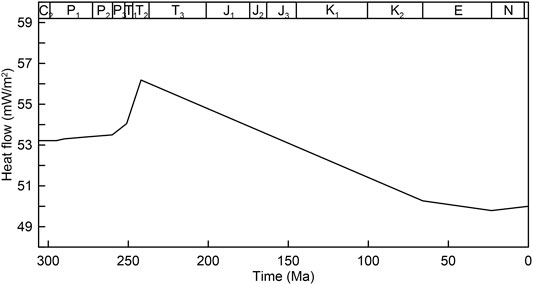
FIGURE 7. Heat flow history of the Fuyang Sag. The line shows the modeling result of heat flow evolution path in the Fuyang Sag since 306 Ma.
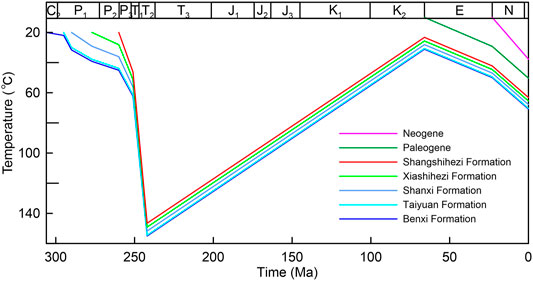
FIGURE 8. Formation temperature history of the Fuyang Sag. Different color lines refer to the modeling results of temperature evolution path of different formations with geological time.
According to the research results of the thermal history of WFD-1, the maturity evolution histories of the main source rocks (P2x, P1s, C2t) in the Fuyang Sag were simulated (Figure 9). Before the Middle Permian, the three sets of main source rocks in the Fuyang Sag were buried and matured slowly under the influence of stable subsidence and sedimentation of the regional tectonic environment. After entering the Late Permian, due to the convergence and compression of the North China Block and the Yangtze Block by the Indosinian movement, each set of strata in the Fuyang Sag began to settle and bury rapidly. With the slight increase of heat flow and geothermal gradient, the maturity of the three sets of source rocks increased rapidly. Ro reached low maturity stage (0.5%) at 247–246 Ma, early maturity stage (0.7%) at 244–243 Ma, and late maturity stage (1.0%) at 240–236 Ma. During the Yanshanian period, the Fuyang Sag continued to uplift and cool, and the formation temperature continued to decrease. Under this influence, the maturity of each set of source rocks gradually finalized. In the Himalayan period, although the Fuyang Sag was deposited and buried again, the maturity degree did not increase again because the formation temperature experienced by each set of source rocks did not exceed the previous maximum formation temperature.
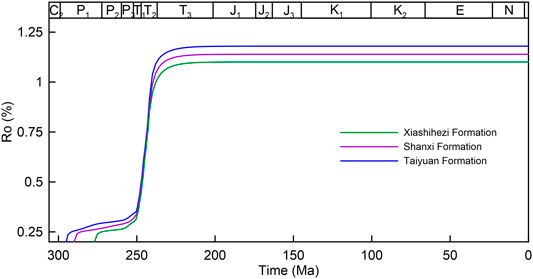
FIGURE 9. The three color lines refer to the maturity evolution modeling results of the three main source rock formations with geological time in the Fuyang Sag.
The Fuyang Sag experienced rapid subsidence and deposition during the Indosinian tectonic period, which provided a favorable structural environment for the development and maturity of source rocks. According to the formation drilled by WFD-1, the thickness of the Carboniferous-Permian in the Fuyang Sag is about 737.6 m, of which the thickness of organic-rich mudstone (TOC > 1%) is about 101.25 m. The Carboniferous-Permian hydrocarbon organic geochemical experimental test results of WFD-1 is shown in Table 1. The experimental test results reveal that the maturity of the Carboniferous-Permian source rocks in the Fuyang Sag was relatively consistent, which generally reached the late maturity stage (1.0%). The organic kerogen types of the Carboniferous-Permian source rocks in the Fuyang Sag are type III or type II2 (Table 2).
The source rocks of the Carboniferous-Permian marine-continental transitional facies are mainly type III kerogen in coal measure organic matter. The hydrocarbon generation mechanism of this kerogen type is mainly the thermal degradation of organic matter under the action of temperature. The main products are small molecular hydrocarbons (such as methane and its homologs) (Fu et al., 1992). Therefore, the hydrocarbon products of the Carboniferous-Permian marine-continental transitional shale are mainly gaseous hydrocarbons, and the yield of liquid hydrocarbons is relatively low. As a result, the marine-continental transitional source rocks of coal measures do not show an obvious gas generation peak of liquid hydrocarbon cracking to generate gaseous hydrocarbon, but a long-term continuous generation of gaseous hydrocarbon (organic matter directly generates small molecule group gaseous hydrocarbon) (Cao et al., 2014). Type III kerogen enters the gas generation window earlier than type I and type II2 kerogen. With the increase of thermal evolution of source rocks, gaseous hydrocarbons are generated continuously, and the range of the gas generation window is larger (Figure 10).
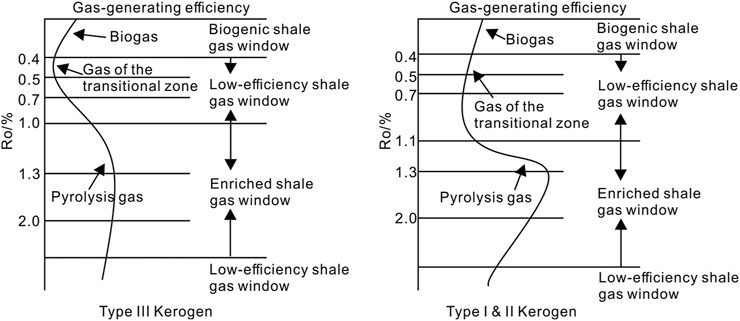
FIGURE 10. Comparison of hydrocarbon generation features of different kerogen. The curve represents the change of gas-generating efficiency with the increase of maturity (Ro value). Modified from Cao et al., 2014.
According to the gas generation efficiency of type III kerogen, the total gas generation is less at a relatively low maturity of source rock (about 1.0%). The total gas generation of marine-continental transitional coal measure source rock continues to increase when the thermal evolution degree rises, which is favorable for type III kerogen to directly generate gaseous hydrocarbons. In addition, high maturity organic matter forms abundant organic dissolution pores in the thermal evolution process, which improves the porosity and provides space for a hydrocarbon reservoir. Therefore, the higher the maturity of the Carboniferous-Permian source rocks with high TOC in the Fuyang Sag, the stronger the adsorption capacity of shale gas, so that the high maturity source rocks have higher shale gas accumulation capacity (Bowker, 2007; Robert and Stephen, 2007).
According to the thermal history modeling result, the main hydrocarbon generation period of the Fuyang Sag is the Indosinian-early Yanshanian. The hydrocarbon accumulated before the tectonic events, which indicates that the Fuyang Sag is an early hydrocarbon generation sag. The present-day average geothermal gradient in the Fuyang Sag is about 25°C/km, and the average heat flow is about 50 mW/m2 (Zhang et al., 2007; He et al., 2009). Both of them are lower than the average geothermal values of eastern China (Hu et al., 2000; Jiang et al., 2019). Under this influence, the Carboniferous-Permian hydrocarbon source rocks with higher maturity in the Fuyang Sag are now buried at a large depth. Therefore, hydrocarbon exploration in the Fuyang Sag should target the Carboniferous-Permian with a buried depth of more than 3500 m to the west of the sag (with higher Ro values).
The Fuyang Sag is a reformed sag after the early hydrocarbon generation. The Carboniferous-Permian formations in the Fuyang Sag experienced the influence of Yanshanian and Himalayan tectonic movements, and the main source rocks experienced the process of sedimentary-uplift and denudation-rebury (Yu et al., 2005; Lin et al., 2011). During the Indosinian period, the Carboniferous-Permian source rocks experienced rapid burial heating, and the maturity of organic matter increased rapidly. When the Ro exceeded 0.5%, source rocks entered the hydrocarbon generation threshold and began to generate hydrocarbon. Then the source rocks reached the late maturity stage (1.0%). During the Yanshanian period, the maturity evolution stagnated, and hydrocarbon generation ceased after regional uplift and denudation. During the Himalayan period, the whole area was deposited and buried again, but the burial depth of the Carboniferous-Permian source rocks did not exceed the maximum burial depth in the previous period, the formation temperature did not reach the highest paleo-temperature. Therefore, the maturity of organic matter could not increase again to form secondary hydrocarbon generation (Lin et al., 2011).
From the late Jurassic to the early Cretaceous, the tectonic environment of the Fuyang Sag was in a stage of compression thrust-strike slip pull basin evolution (Xu et al., 2004) under the background of compression torsion. The fault-folding reformation and uplift denudation in this period may have a certain destructive effect on the hydrocarbon reservoirs formed in the earlier and the same period. Therefore, hydrocarbon exploration in the Fuyang Sag should be based on preservation conditions (Zhao et al., 2011), and the areas with weaker uplift and denudation reconstruction in the later stage, that is, the favorable areas of residual Mesozoic strata, should be optimized.
First, the area with the remaining Mesozoic strata indicates that the area experienced weak tectonic events during the Yanshanian period. Since the upper Paleozoic formation was not exposed, the marine-continental transitional shale itself is a barrier for the preservation of self-generating and self-storing shale oil and gas reservoirs. The upper Paleozoic strata have not been damaged by tectonic events, which is conducive to the formation of large area, widely and continuously distributed unconventional oil and gas reservoirs, and it is favorable for the preservation of oil and gas resources generated in the early stage. Second, the lower porosity, permeability, and other physical properties of the overlying Mesozoic strata can form favorable caps for Paleozoic hydrocarbon accumulation and become good caprocks for the Carboniferous-Permian shale oil and gas reservoirs. Third, in the later re-burial process, the overlying strata may have a certain hydrocarbon-generating capacity due to the effect of burial maturation, which can not only seal the Paleozoic oil and gas reservoir by the poor physical properties but also produce the hydrocarbon concentration sealing effect (Fu et al., 2008) due to hydrocarbon generation and expulsion. In addition, the overpressure source rock even has the pressure sealing effect, which is more conducive to the sealing and preservation of the lower oil and gas reservoir. Fourth, the thick overlying strata of shale oil and gas reservoirs are also conducive to hydrocarbon accumulation and preservation.
Although no magmatic activity was identified in the drilling and geophysical exploration in the Fuyang Sag, igneous rocks were encountered in several drilling wells in the surrounding tectonic units. Therefore, the impact of magmatism on oil and gas reservoirs should be considered in hydrocarbon exploration in the study area. On the one hand, the magmatic activity prior to the mass generation of hydrocarbon is conductive to the process. The high temperature, high pressure, and active chemical properties of magma can promote hydrocarbon generation, improve the reservoir property of surrounding rock, and form abnormal high-pressure fields and various types of traps, which are conducive to oil and gas accumulation (Wan et al., 2014). On the other hand, magmatic activity after the mass generation of hydrocarbon is destructive to the process. The newly formed high-temperature geothermal field may destroy the reservoir and its structure, causing oil and gas to escape upward. After the high-temperature magma intrudes into the source rock, it will bake the surrounding source material and generate hydrocarbon to carbonize it (Zhang et al., 2016). The Yanshanian movement peaked from the late Jurassic to the early Cretaceous, with regional high geothermal anomalies caused by intense magmatic and volcanic activities. Hydrocarbon had been generated before the Yanshanian movement in the Fuyang Sag, so the late magmatic activities are destructive to the early oil and gas reservoirs. Therefore, in the hydrocarbon exploration in the Fuyang Sag, the igneous rock development area should be kept off to avoid the influence of magmatic activities on the Carboniferous-Permian oil and gas reservoirs.
1) The burial history of the Fuyang Sag since the Late Paleozoic can be divided into four stages. Before the Middle Permian, the Fuyang Sag was in a stable sedimentation stage. After the Late Permian, the study area experienced rapid subsidence and deposition. Long-term continuous uplift and denudation occurred in the Fuyang Sag during the Yanshanian tectonic period. The sedimentation in the Fuyang Sag was recovered in the Cenozoic era.
2) The heat flow evolution history of the Fuyang Sag since the Late Paleozoic can be characterized by ascending first and descending afterward. The terrestrial heat flow of the Fuyang Sag in the late Paleozoic was about 53 mW/m2. At the end of the Indosinian period, the terrestrial heat flow increased slightly to about 56 mW/m2. After that, the terrestrial heat flow slowly decreased to about 50 mW/m2. The terrestrial heat flow tends to be stable in the Cenozoic era. The formation temperature history of the Fuyang Sag shows the same trend as the burial history.
3) The three sets of main source rocks in the Fuyang Sag were slowly buried and matured before the Middle Permian. During the Permian, the maturity of the three sets of source rocks increased rapidly, with Ro reaching the late maturity stage of 1.0%. The maturity of each set of source rocks was gradually finalized in the Yanshanian period. During the Himalayan period, the thermal evolution degree of each set of source rocks did not increase again.
4) The organic matter type of the Carboniferous-Permian source rocks of marine-continental transitional facies in the Fuyang Sag is mainly type III kerogen. This kerogen type generates and expels more hydrocarbon at high maturity. Influenced by the thermal history of the Fuyang Sag, the source rocks with deeper burial depth have greater potential for oil and gas exploration. The Fuyang Sag is a reformed sag after the early hydrocarbon generation. The areas in the sag with weaker uplift and denudation reformation in the later period are favorable areas for hydrocarbon exploration.
The raw data supporting the conclusion of this article will be made available by the authors, without undue reservation.
The first author PG completed most of the work of the article, the second author ZL analyzed the Well WFD-1 and the seismic profile, the third author MM revised the manuscript and polished the language, the fourth author SL designed the experimental tests and revised the manuscript, and the fifth author HZ analyzed the vitrinite reflectance data. All authors listed have made a substantial, direct, and intellectual contribution to the work and approved it for publication.
This study is financially supported by China Geological Survey Project (No. DD20190088, No. DD20190561, No. DD20190725), the Project for high-level-innovation Talents in Science and Technology (No. 12110600000018003918) and Guangxi Government Procurement Project (No. (2021)-3421-001-012). All funds received were for experimental fees and open access publication fees.
The authors declare that the research was conducted in the absence of any commercial or financial relationships that could be construed as a potential conflict of interest.
All claims expressed in this article are solely those of the authors and do not necessarily represent those of their affiliated organizations, or those of the publisher, the editors, and the reviewers. Any product that may be evaluated in this article, or claim that may be made by its manufacturer, is not guaranteed or endorsed by the publisher.
We sincerely thank two reviewers for their valuable comments and suggestions, which significantly improved the manuscript.
Bowker, K. A. (2007). Barnett Shale Gas Production, Fort Worth basin: Issues and Discussion. Bulletin 91, 523–533. doi:10.1306/06190606018
Burnham, A. K., and Sweeney, J. J. (1989). A Chemical Kinetic Model of Vitrinite Maturation and Reflectance. Geochimica Et Cosmochimica Acta 53, 2649–2657. doi:10.1016/0016-7037(89)90136-1
Cao, D., Wang, C., Li, J., Qin, R., Yang, G., and Zhou, J. (2014). Basic Characteristics and Accumulation Rules of Shale Gas in Coal Measures (In Chinese with English Abstract). Coal Geology. Exploration 42, 25–30. doi:10.3969/j.issn.1001-1986.2014.04.006
Falvey, D. A., and Middleton, M. F. (2005). Passive continental Margins: Evidence for a Prebreakup Deep Crustal Metamorphic Subsidence Mechanism. Oceanologica Acta 4, 103–114.
Fu, G., Liu, B., and Lv, Y. (2008). Comprehensive Evaluation Method for Sealing Ability of Mudstone Caprock to Gas in Each Phase. Lithologic Reservoirs 20, 16–20. doi:10.3969/j.issn.1673-8926.2008.01.004
Fu, J., Liu, D., and Cheng, G. (1992). Coal Hydrocarbon Geochemistry. Beijing: Science Press. (in Chinese).
Gao, P., Li, Z., Li, S., Zhou, Z., Wei, S., and Zhang, H. (2021). An Important Discovery of High-Quality Source Rocks of marine-continental Transitional Facies, Obtained by Borehole WFD-1, Fuyang Area, Anhui Province (In Chinese). China Geology. 48, 1659–1660. doi:10.12029/gc20210527
Gao, P., Qiu, Q., Jiang, G., Zhang, C., Hu, S., Lei, Y., et al. (2018). Present-day Geothermal Characteristics of the Ordos Basin, Western North China Craton: New Findings from Deep Borehole Steady-State Temperature Measurements. Geophys. J. Int. 214, 254–264. doi:10.1093/gji/ggy127
Hanks, C. L., Parris, T. M., and Wallace, W. K. (2006). Fracture Paragenesis and Microthermometry in Lisburne Group Detachment Folds: Implications for the thermal and Structural Evolution of the Northeastern Brooks Range, Alaska. Bulletin 90, 1–20. doi:10.1306/08090504134
He, Z., Liu, C., Zhao, J., and Liu, Y. (2009). A Study on Geothermal Field and its Geological Significance in Southern Area of the North China Craton. Geol. Rev. 55, 428–434. doi:10.16509/j.georeview.2009.03.012
He, Z. (2009). The Research of Palaeozoic thermal History and its Oil-Gas Geological Significance in Zhoukou Depression. Xi’an: Northwest University. Master Master.
Hu, S., Fu, M., Yang, S., Yuan, Y., and Wang, J. (2007). Palaeogeothermal Response and Record of Late Mesozoic Lithospheric Thinning in the Eastern North China Craton. Geol. Soc. Lond. Spec. Publications 280, 267–280. doi:10.1144/sp280.13
Hu, S., He, L., and Wang, J. (2000). Heat Flow in the continental Area of China: a New Data Set. Earth Planet. Sci. Lett. 179, 407–419. doi:10.1016/s0012-821x(00)00126-6
Hu, S., O’Sullivan, P. B., Raza, A., and Kohn, B. P. (2001). Thermal History and Tectonic Subsidence of the Bohai Basin, Northern China: a Cenozoic Rifted and Local Pull-Apart basin. Phys. Earth Planet. Interiors 126, 221–235. doi:10.1016/s0031-9201(01)00257-6
Huang, Z., Gao, C., and Ji, R. (2005). Analysis of Evolution of Meso-Cenozoic Basins in Southern North China (In Chinese with English Abstract). Oil Gas Geology. 26, 252–256. doi:10.11743/ogg20050220
Jiang, G., Hu, S., Shi, Y., Zhang, C., Wang, Z., and Hu, D. (2019). Terrestrial Heat Flow of continental China: Updated Dataset and Tectonic Implications. Tectonophysics 753, 36–48. doi:10.1016/j.tecto.2019.01.006
Kuang, H., Liu, Y., Peng, X., Yang, F., Chen, M., Cen, C., et al. (2009). Sedimentary and Tectonic Features and Proto-basin of Early Cretaceous Tanzhuang —Shenqiu Sag, Zhoukou Depression, in Southern Area of North China Craton (In Chinese with English Abstract). Geol. Rev. 55, 804–815. doi:10.16509/j.georeview.2009.06.005
Lerche, I., Yarzab, R., and Kendall, C. S. C. (1984). Determination of Paleoheat Flux from Vitrinite Reflectance Data. AAPG Bull. 68, 1704–1717. doi:10.1306/ad461980-16f7-11d7-8645000102c1865d
Li, Z., Xu, M., Zhao, P., Sun, Z., and Zhu, C. (2013). Geothermal Regime and Hydrocarbon Kitchen Evolution in the Jianghan Basin. Sci. China Earth Sci. 56, 240–257. doi:10.1007/s11430-012-4462-8
Liang, B., and Liu, H. (2014). Sedimentary basin Evolution and Geological Elements of Unconventional Oil and Gas Reservoirs in Fuyang Area, Anhui Province (In Chinese with English Abstract). J. Palaeogeogr. 16, 179–192. doi:10.7605/gdlxb.2014.02.017
Lin, X., Chen, Q., and Li, J. (2011). Distribution and Geochemical Characteristics of Permian Source Rocks in the Southern North-China (In Chinese with English Abstract). Mar. Geology. Front. 27, 21–26. doi:10.16028/j.1009-2722.2011.04.004
Liu, G., Sun, B., Huang, C., Luo, X., Zhang, L., Zhou, X., et al. (2009). Potential of the Deep Oil-Gas Reservior-Forming and Direction of the Deep Oil-Gas Exploitation in Southern North China Basin (In Chinese with English Abstract). J. Graduates 30, 113–123. doi:10.13471/j.cnki.acta.snus.2009D113
Liu, Q., He, L., Huang, F., and Zhang, L. (2016). Cenozoic Lithospheric Evolution of the Bohai Bay Basin, Eastern North China Craton: Constraint from Tectono-thermal Modeling. J. Asian Earth Sci. 115, 368–382. doi:10.1016/j.jseaes.2015.10.013
Lu, Y., Ding, H., Shi, Y., and Chen, C. (2011). Exploration prospect of Unconventional Natuaral Gas in Fuyang Area (In Chinese with English Abstract). Complex Hydrocarbon Reservoirs 4, 5–9. doi:10.16181/j.cnki.fzyqc.2011.04.002
Ma, B. (2006). Study on the Condition of Oil and Gas Reservoir in the Fuyang Region (In Chinese with English Abstract). Geology. Anhui 16, 31–35. doi:10.3969/j.issn.1005-6157.2006.01.031
Morgan, P. (1984). The thermal Structure and thermal Evolution of the continental Lithosphere. Phys. Chem. Earth 15, 107–193. doi:10.1016/0079-1946(84)90006-5
Price, L. C. (1983). Geologic Time as a Parameter in Organic Metamorphism and Vitrinite Reflectance as an Absolute Paleogeothermometer. J. Pet. Geol 6, 5–37. doi:10.1111/j.1747-5457.1983.tb00260.x
Qiu, N., Hu, S., and He, L. (2004). Theory and Application of Thermal Regime in Sedimentary Basin (In Chinese). Beijing: Petroleum Industry Press.
Qiu, N., Li, H., and Jin, Z. (2005). Study of the thermal History Reconstruction for Lower Paleozoic Carbonate Succession (In Chinese with English Abstract). Earth Sci. Front. 12, 561–567. doi:10.13745/j.esf.sf.2005.4.561
Qiu, N., Zuo, Y., Chang, J., and Li, W. (2014). Geothermal Evidence of Meso-Cenozoic Lithosphere Thinning in the Jiyang sub-basin, Bohai Bay Basin, Eastern North China Craton. Gondwana Res. 26, 1079–1092. doi:10.1016/j.gr.2013.08.011
Robert, G. L., and Stephen, C. R. (2007). Mississippian Barnett Shale: Lithofacies and Depositional Setting of a Deep–Water Shale–Gas Succession in the Fort Worth basin, Texas. AAPG Bull. 91, 579–601. doi:10.1306/11020606059
Sclater, J. G., and Christie, P. A. F. (1980). Continental Stretching: An Explanation of the Post-Mid-Cretaceous Subsidence of the central North Sea Basin. J. Geophys. Res. 85, 3711–3739. doi:10.1029/jb085ib07p03711
Sun, X., Zhang, M., Long, S., Hao, F., Liu, P., and Liu, C. (2004). Overthrust Tectonic in Northern Qinling-Dabie Orogenic belt and basin-controlling Faults in Zhoukou Depression and Hefei basin (In Chinese with English Abstract). OIL GAS GEOLOGY. 25, 191–198. doi:10.11743/ogg20040213
Sweeney, J. J., and Burnham, A. K. (1990). Evaluation of a Simple Model of Vitrinite Reflectance Based on Chemical Kinetics. AAPG Bull. 74, 1559–1570. doi:10.1306/0c9b251f-1710-11d7-8645000102c1865d
Tang, X., Yang, S., and Hu, S. (2014). Thermal and Maturation History of Jurassic Source Rocks in the Kuqa Foreland Depression of Tarim Basin, NW China. J. Asian Earth Sci. 89, 1–9. doi:10.1016/j.jseaes.2014.03.023
Tissot, B., Pelet, R., and Ungerer, P. (1987). Thermal History of Sedimentary Basins, Maturation Indices, and Kinetics of Oil and Gas Generation. AAPG Bull. 71, 1445–1466. doi:10.1306/703c80e7-1707-11d7-8645000102c1865d
Wan, C., Jin, Q., Li, J., and Miu, J. (2014). Outline on Magmatic Activities Controlling Oil-Gas Theory in Rift Basins. Pet. Geology. Recovery Efficiency 21, 1–5. doi:10.13673/j.cnki.cn37-1359/te.2014.01.001
Wang, Z., He, H., and Cheng, K. (1999). Exploration prospect of Paleozoic Primary Oil and Gas Reservoirs in North China (In Chinese). ACTA PETROLEI SINICA 20, 1–6. doi:10.7623/syxb199902001
Waples, D. W. (1980). Time and Temperature in Petroleum Formation: Application of Lopatin's Method to Petroleum Exploration. AAPG Bull. 64, 916–926. doi:10.1306/2f9193d2-16ce-11d7-8645000102c1865d
Wu, F., Chen, Z., and Zhang, N. (1992). Sedimentary Types and Organic Characteristics of Hydrocarbon Source Rocks of Carboniferous-Permian, South Part of Huabei (In Chinese with English Abstract). Earth Sci. 17, 687–698. doi:10.3799/dqkx.1992.689
Xie, D., He, M., Zhou, L., and Xie, Q. (2006). Characteristics of Overthrust Structures on Northern Edge of East Qinling - Dabie Orogenic belt and Hydrocarbon Potentials (In Chinese with English Abstract). OIL GAS GEOLOGY. 27, 48–55. doi:10.11743/ogg20060109
Xie, D., and Zhou, L. (2006). Discussion on Hydrocarbon Generation Potential and Secondary Hydrocarbon Generation of Organic Matter from Permo-Carboniferous Coal Measures in the Southern North China (In Chinese with English Abstract). Coal Geology. Exploration 34, 30–34. doi:10.3969/j.issn.1001-1986.2006.01.030
Xu, H., Zhao, Z., Lu, F., Yang, Y., Tang, Z., Sun, G., et al. (2004). Tectonic Evolution of the Nanhuabei Area and Analysis about its Petroleum Potential (In Chinese with English Abstract). Geolecloni ca el Metallogenia 28, 450–463. doi:10.16539/j.ddgzyckx.2004.04.450
Xu, H., Zhao, Z., Yang, Y., and Tang, Z. (2003). Structural Pattern and Structural Style of the Southern North China Basin (In Chinese with English Abstract). ACTA GEOSCIENTIA SINICA 24, 27–33. doi:10.3321/j.issn:1006-3021.2003.01.005
Xu, X., Chen, X., Lei, M., Li, S., Zhou, X., and Wu, M. (2011). Exploration Prospects of the Carboniferous and Permian in the Southern North China (In Chinese with English Abstract). Pet. Geology. Expeximent 33, 148–154. doi:10.11781/sysydz201102148
Yang, M., Liu, C., Zeng, P., Bai, H., and Zhou, J. (2012). Prototypes of Late Triassic Sedimentary Basins of North China Craton (NCC) and Deformation Pattern of its Early Destruction (In Chinese with English Abstract). Geol. Rev. 58, 1–18. doi:10.16509/j.georeview.2012.01.011
Yang, P. (2017). Carboniferous-Triassic Erosion Recovery in Fuyang Area (In Chinese). Inner Mongolia Petrochemical Industry 2017 (7), 38–41. doi:10.3969/j.issn.1006-7981.2017.07.038
Yu, H., Lu, F., Guo, Q., Lu, W., Wu, J., and Han, S. (2005). Proto-sediment basin Types and Tectonic Evolution in the Southern Edge of North China Plate (In Chinese with English Abstract). Pet. Geology. Expeximent 27, 111–117. doi:10.11781/sysydz200502111
Zhang, J. (2016). Analysis on Hydrocarbon Generation Characteristics of Carboniferous-Permian Source Rocks in Fuyang Exploration Area (In Chinese). J. Yangtze Univ. (Natural Sci. Edition) 13, 18–23. doi:10.3969/j.issn.1673-1409.2016.35.018
Zhang, P., Wang, L., Liu, S., Li, C., and Ding, Z. (2007). Geothermal Field in the South Huabei Basins (In Chinese with English Abstract). Prog. Geophys. 22, 604–608. doi:10.6038/pg2007EE0604
Zhang, Q., Jin, W., Wang, J., Chen, W., Li, C., Jiao, S., et al. (2016). Relationship between Magma-thermal Field and Hydrocarbon Accumulation (In Chinese with English Abstract). Prog. Geophys. 31, 1525–1541. doi:10.6038/pg20160416
Zhao, J., Liu, C., He, Z., and Liu, Y. (2010). Thermal Evolution Degree and its Hydrocarbon Geological Implications of the Main Strata Series in the Southern North China Craton (In Chinese with English Abstract). Pet. Geology. Expeximent 32, 101–107. doi:10.11781/sysydz201002101
Zhao, J., Liu, C., Liu, Y., He, Z., Mao, W., and Zhu, B. (2011). Reconstruction of thermal Evolutionary History of the Upper Paleozoic in the Southern North China (In Chinese with English Abstract). Oil Gas Geology. 32, 64–74. doi:10.11743/ogg20110108
Zhao, Z., Li, D., Zhu, Y., Zhou, J., and Feng, J. (2001). Structural Evolution and Oil and Gas System Analysis of Hefei Basin (In Chinese). Pet. Exploration Development 28, 8–13. doi:10.3321/j.issn:1000-0747.2001.04.008
Zhu, C., Xu, M., Yuan, Y., Zhao, Y., Shan, J., He, Z., et al. (2010). Palaeogeothermal Response and Record of the Effusing of Emeishan Basalts in the Sichuan basin. Chin. Sci. Bull. 55, 949–956. doi:10.1007/s11434-009-0490-y
Zhu, H., Pang, X., and Wang, Y. (2006). Characteristics of Source Rocks in Permo-Carboniferous Coal Measure Formations in Fuyang Area (In Chinese with English Abstract). Nat. Gas Industry 26, 18–20. doi:10.3787/j.issn.1000-0976.2006.11.018
Zuo, Y., Qiu, N., Pang, X., Chang, J., Hao, Q., and Gao, X. (2013). Geothermal Evidence of the Mesozoic and Cenozoic Lithospheric Thinning in the Liaohe Depression. J. Earth Sci. 24, 529–540. doi:10.1007/s12583-013-0347-9
Keywords: tectono-thermal evolution, hydrocarbon generation, Carboniferous-Permian source rocks, oil and gas exploration, Fuyang Sag
Citation: Gao P, Li Z, Miao M, Li S and Zhang H (2022) Tectono-Thermal Evolution and its Significance of Hydrocarbon Exploration in the Fuyang Sag, Southern North China Basin: A Case Study of Well WFD-1. Front. Earth Sci. 9:786849. doi: 10.3389/feart.2021.786849
Received: 30 September 2021; Accepted: 28 December 2021;
Published: 10 February 2022.
Edited by:
Yanlong Kong, Institute of Geology and Geophysics (CAS), ChinaReviewed by:
Chuanqing Zhu, China University of Petroleum, ChinaCopyright © 2022 Gao, Li, Miao, Li and Zhang. This is an open-access article distributed under the terms of the Creative Commons Attribution License (CC BY). The use, distribution or reproduction in other forums is permitted, provided the original author(s) and the copyright owner(s) are credited and that the original publication in this journal is cited, in accordance with accepted academic practice. No use, distribution or reproduction is permitted which does not comply with these terms.
*Correspondence: Peng Gao, cHMxX2dhb0AxNjMuY29t
Disclaimer: All claims expressed in this article are solely those of the authors and do not necessarily represent those of their affiliated organizations, or those of the publisher, the editors and the reviewers. Any product that may be evaluated in this article or claim that may be made by its manufacturer is not guaranteed or endorsed by the publisher.
Research integrity at Frontiers

Learn more about the work of our research integrity team to safeguard the quality of each article we publish.